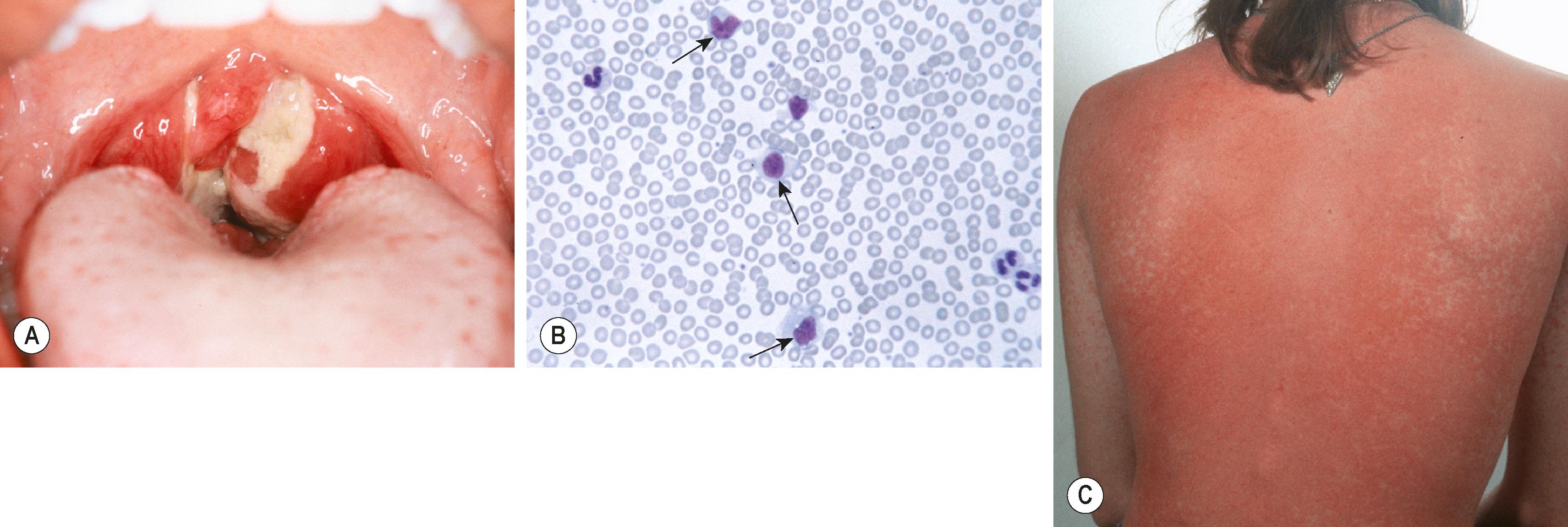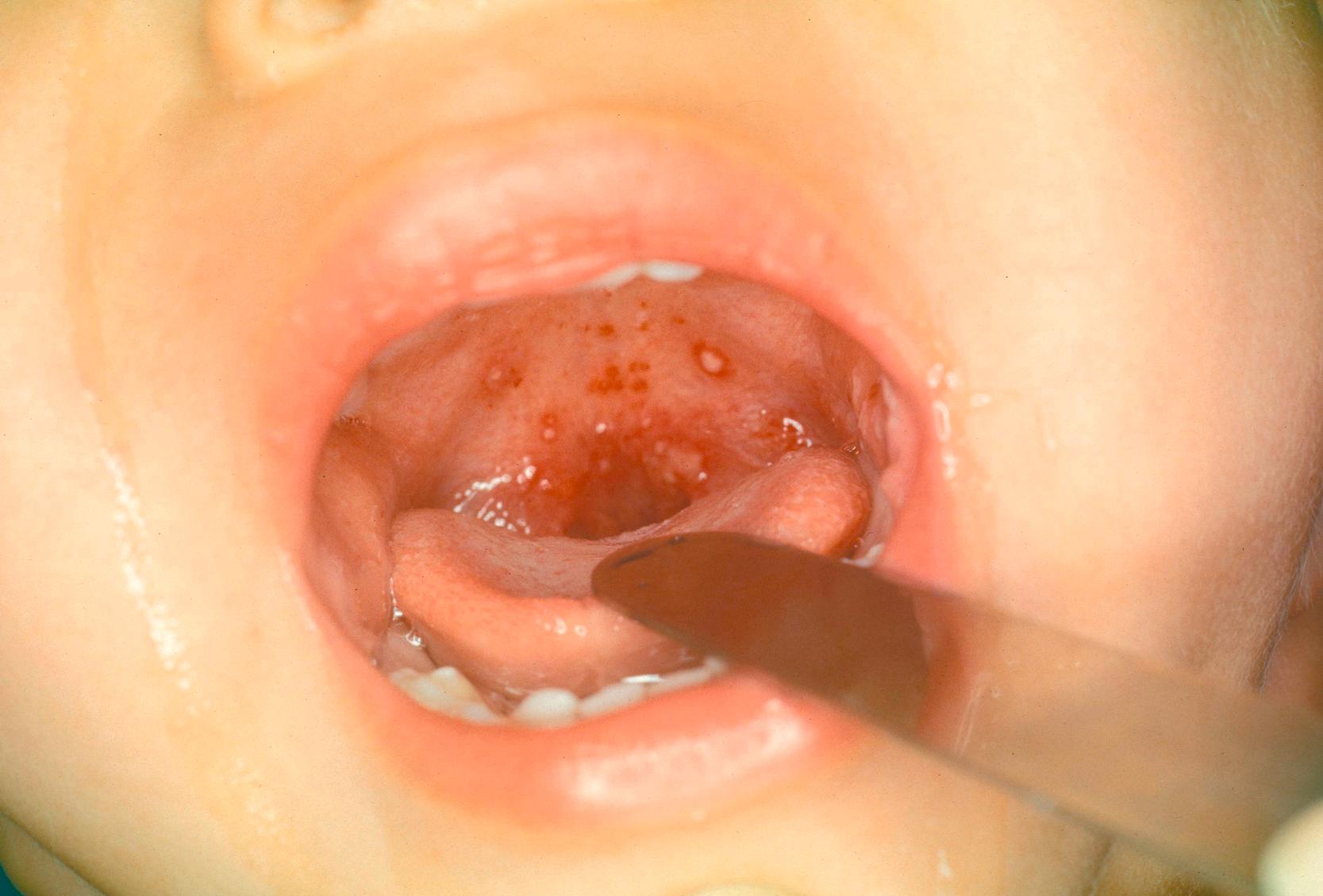Physical Address
304 North Cardinal St.
Dorchester Center, MA 02124
Acute pharyngitis is one of the most common illnesses for which children and adults in the US seek medical care. There were approximately 10.4 million visits to physician offices for pharyngitis in 2016. It is estimated that a rapid antigen detection test (RADT) for group A Streptococcus was performed at 19 million office visits, and throat culture was performed at 8 million visits. There were 2.2 million emergency department visits for pharyngitis in 2017. Table 27.1 provides a partial list of etiologic agents for acute pharyngitis. Most cases of pharyngitis in children and adolescents are caused by viruses and are benign and self-limited. In North America, and most industrialized countries, Group A β-hemolytic Streptococcus (GAS) ( Streptococcus pyogenes ) is the most important bacterial etiology. GAS pharyngitis is the necessary antecedent to development of acute rheumatic fever (ARF). Accurate, timely diagnosis of GAS pharyngitis and treatment with an appropriate antibiotic will reliably prevent ARF. Strategies for the diagnosis and treatment of pharyngitis in children and adolescents depend on differentiating patients with GAS pharyngitis who should receive antimicrobial therapy from the majority who have viral pharyngitis and should not receive them. These are critical to prevention of ARF as well as essential in outpatient antimicrobial stewardship.
| Etiologic Agents | Associated Disorders or Clinical Findings |
|---|---|
| Bacteria | |
| Group A Streptococcus | Scarlet fever |
| Groups C and G streptococci | |
| Mixed anaerobes | Vincent angina |
| Neisseria gonorrhoeae | |
| Corynebacterium diphtheriae | Diphtheria |
| Arcanobacterium haemolyticum | Scarlatiniform rash |
| Yersinia enterocolitica | Enterocolitis |
| Yersinia pestis | Plague |
| Francisella tularensis | Tularemia |
| Fusobacterium necrophorum | Lemierre syndrome (jugular vein septic thrombophlebitis) |
| Viral | |
| Rhinovirus | Common cold |
| Coronavirus | Common cold |
| Novel coronavirus (SARS-CoV-2) | COVID-19, MIS-C |
| Adenovirus | Pharyngoconjunctival fever; acute respiratory disease |
| Herpes simplex virus types 1 and 2 | Gingivostomatitis |
| Parainfluenza virus | Common cold; croup |
| Coxsackievirus | Herpangina; hand-foot-mouth disease |
| Epstein-Barr virus | Infectious mononucleosis |
| Cytomegalovirus | Cytomegalovirus mononucleosis |
| HIV | Primary HIV infection |
| Measles (rubeola) | Koplik spots |
| Mycoplasma | |
| Mycoplasma pneumoniae | Acute respiratory illness; pneumonia |
| Chlamydia | |
| Chlamydophila psittaci | Acute respiratory illness; pneumonia |
| Chlamydophila pneumoniae | Pneumonia |
| Noninfectious Causes | |
| Gastroesophageal reflux disease | Heartburn |
| Laryngopharyngeal reflux | Cough, hoarseness |
| PFAPA syndrome | Periodic fever, aphthous ulcers, adenitis |
| Allergic pharyngitis | Scratchy sensation, postnasal drip, hoarseness |
| Inflammatory bowel disease | Pharyngeal and/or oral ulcers; GI manifestations |
| Kawasaki disease | Other typical findings (extremity changes, conjunctival hyperemia) |
Upper respiratory tract viral infections are typically spread by contact with oral or respiratory secretions and frequently occur during the fall, winter, and spring seasons. The symptoms of most viral upper respiratory tract infections are mild, and the etiologies often are clinically indistinguishable from each other; cough and coryza frequently are more prominent than pharyngitis. Respiratory viruses that are frequent causes of pharyngitis include influenza virus, parainfluenza virus, rhinoviruses, coronaviruses (including the novel coronavirus, SARS-CoV-2), adenoviruses, human metapneumovirus (HMPV), respiratory syncytial virus (RSV), enteroviruses, herpes simplex virus (HSV), and Epstein-Barr virus (EBV).
Numerous bacteria, as well as noninfectious conditions, can cause pharyngitis ( Table 27.1 ). GAS is the most commonly identified bacterial cause of acute pharyngitis, accounting for 15%–30% of pharyngitis in children and adolescents. Using polymerase chain reaction (PCR), Fusobacterium necrophorum , the most frequent cause of Lemierre syndrome, has been identified in adolescents and young adults with uncomplicated pharyngitis. , Group C (GCS) and group G (GGS) β-hemolytic streptococci, Arcanobacterium haemolyticum , and Neisseria gonorrhoeae are occasional causes of pharyngitis in adolescents. Common bacteria such as Staphylococcus aureus, Haemophilus influenzae, and Streptococcus pneumoniae are often isolated from throat cultures of children and adolescents with acute pharyngitis, but their etiologic role is not established.
Clinical findings such as conjunctivitis, cough, hoarseness or croup, coryza, anterior stomatitis, discrete ulcerative oral lesions, viral exanthem, myalgia, and diarrhea suggest a virus as the cause of acute pharyngitis ( Box 27.1 ). Some viral causes of pharyngitis can be identified when there are features characteristic of a specific viral syndrome. EBV, HSV, enterovirus, and adenovirus infections can sometimes be identified by a syndromic presentation.
Sudden onset
Sore throat
Fever
Scarlet fever rash
Headache
Nausea, vomiting, and abdominal pain
Inflammation of pharynx and tonsils
Patchy discrete tonsillar exudates
Tender, enlarged anterior cervical nodes
Patient age 5–15 years
Presentation in winter or early spring
History of exposure
Conjunctivitis
Coryza
Cough
Hoarseness, croup
Myalgia
Diarrhea
Characteristic exanthem and/or enanthem
EBV pharyngitis during infectious mononucleosis can be severe, with pharyngeal findings identical to those of GAS pharyngitis ( Fig. 27.1A ). Severe exudative tonsillitis in conjunction with generalized lymphadenopathy, significant posterior cervical adenopathy, and splenomegaly with or without hepatomegaly should focus the clinician on EBV as the etiology. Acute upper respiratory obstruction can result from severe tonsillar hypertrophy and inflammation. Fever and pharyngitis typically last 1–3 weeks, whereas the lymphadenopathy and hepatosplenomegaly resolve over 3–6 weeks. Laboratory findings include atypical lymphocytosis ( Fig. 27.1B ), heterophile antibodies, viremia (detected by PCR), and specific antibodies to EBV antigens. Especially if amoxicillin has been given, an intense maculopapular rash can occur ( Fig. 27.1C ).

Primary oral HSV infections usually occur in young children and present with acute gingivostomatitis associated with ulcerating vesicular lesions throughout the anterior mouth and lips, sparing the posterior pharynx. Patients with HSV gingivostomatitis often have high fever; the illness takes up to 2 weeks to resolve. Pain can be intense, and poor oral intake can lead to dehydration. In adolescents and adults, HSV can cause mild pharyngitis that may or may not be associated with typical vesicular, ulcerating lesions.
Enterovirus infections (coxsackievirus, echovirus, and enterovirus) are associated with erythematous pharyngitis without tonsillar exudates or cervical lymphadenopathy. Fever can be prominent, but resolution usually occurs within a few days. Herpangina is a specific syndrome caused by coxsackievirus A or B or echoviruses, characterized by fever and painful, discrete, grey-white papulovesicular or ulcerative lesions on an erythematous base in the posterior oropharynx ( Fig. 27.2 ). Hand-foot-and-mouth disease is characterized by painful vesicles and ulcers throughout the oropharynx associated with vesicles on the palms, soles, and sometimes on the trunk or extremities. The most common agent is Coxsackie A16, but Enterovirus 71 and Coxsackie A6 can also cause hand-foot-and-mouth disease. Enteroviral lesions usually resolve within 7 days.

Adenovirus pharyngitis is associated with fever, erythema of the pharynx, enlarged tonsils with exudate, and enlarged cervical lymph nodes. The presence of conjunctivitis in association with pharyngitis is highly suggestive of the adenovirus syndrome called pharyngoconjunctival fever . Adenovirus pharyngitis can persist for up to 7 days and conjunctivitis (sometimes simulating periorbital cellulitis) up to 14 days, after which both resolve spontaneously. Outbreaks of pharyngoconjunctival fever have been associated with transmission in swimming pools. Widespread epidemics and sporadic cases also occur.
Early in measles the oropharynx can be intensely erythematous; the presence of the pathognomonic enanthem, Koplik spots, on the buccal mucosa opposite the first and second molars occurs 2–3 days before rash.
Infection with the novel coronavirus, SARS-CoV-2, can present with pharyngitis; 12.8% of US children ≤9 years and 28.6% of those 10–19 years report sore throat. Systemic infections with cytomegalovirus (CMV) and human immunodeficiency virus (HIV) can include pharyngitis.
GCS and GGS pharyngitis typically resemble GAS pharyngitis and are diagnosed most commonly in adolescents and young adults. GCS pharyngitis can cause elevated levels of serum anti-streptolysin O (ASO) antibody. When sought, GCS is a relatively common cause of acute pharyngitis among college students and adults seeking urgent care. , Outbreaks of GCS pharyngitis related to consumption of contaminated food products, especially unpasteurized cow milk, have occurred in families and schools. Serious complications, including endocarditis and meningitis, have been described. A community-wide outbreak of pharyngitis among children was described in which GGS was isolated from 25% of 222 consecutive children with acute pharyngitis seen in a private pediatric office. Restriction enzyme analysis suggested that 75% of isolates belonged to the same GGS clone, implying person-to-person transmission. The role of GCS in acute, endemic pharyngitis remains unclear.
Arcanobacterium haemolyticum pharyngitis is a rare cause of pharyngitis among teenagers and young adults. It is generally indistinguishable from GAS pharyngitis and can manifest a fine red papular rash that resembles the rash of scarlet fever. Cohort studies of Arcanobacterium pharyngitis have not demonstrated occurrence of complications but numerous case reports describe associated sepsis and soft-tissue infections. A. haemolyticum does not grow well on sheep blood agar; many laboratories do not employ human or horse blood agar that is preferred for growth.
Fusobacterium necrophorum causes pharyngitis primarily in older adolescents and adults (15–30 years old). Prevalence has varied from 10% to 48% of patients in studies of non-GAS pharyngitis, but there have not been any large surveillance studies. F. necrophorum was detected by PCR in 20.5% of patients with pharyngitis in a study in a university health clinic and in 9.4% of a convenience sample of asymptomatic patients. Patients with pharyngitis and F. necrophorum detection had signs and symptoms similar to GAS pharyngitis: about one-third had fever, one-third had tonsillar exudates, two-thirds had anterior cervical lymphadenopathy, and most did not have cough. F. necrophorum is important as the cause of about 80% of cases of Lemierre syndrome, internal jugular vein septic thrombophlebitis. Patients with Lemierre syndrome present initially with fever, sore throat, exudative pharyngitis, and/or peritonsillar abscess, not unlike F. necrophorum PCR-positive pharyngitis cases observed in a university health clinic. Symptoms can persist, neck pain and swelling develop, and the patient appears toxic. In addition to development of septic shock, metastatic complications from septic emboli can involve the lungs, bones and joints, central nervous system, abdominal organs, and soft tissues. The case fatality rate of Lemierre syndrome is 4%–9%. F. necrophorum is difficult to isolate from a throat culture, and diagnostic testing with PCR is not generally available.
Gonococcal pharyngeal infections are most common in adolescents and adults related to oral—genital sexual contact. Pharyngeal infections usually are asymptomatic, but patients can have acute ulcerative or exudative pharyngitis with fever and cervical lymphadenitis. Young children with documented gonococcal disease must be evaluated for sexual abuse.
Diphtheria, caused by toxin-producing Corynebacterium diphtheriae , is endemic in many areas of the world, including countries in Eastern Europe, Africa, Asia, the Middle East, and Latin America. Immunization with diphtheria toxoid has made it rare in most developed countries; there are fewer than 5 cases reported annually in the US. From 2016 to 2019 diphtheria outbreaks occurred in Indonesia, Bangladesh, Myanmar, Vietnam, Venezuela, Haiti, South Africa, and Yemen. Diphtheria can be considered in patients with recent travel to or from an endemic area, especially if they are underimmunized. Key physical findings are bull neck (extreme neck swelling) and a gray pharyngeal pseudomembrane that can cause respiratory obstruction.
M. pneumoniae and C. pneumonia e cause pharyngitis but are infrequently recognized. Development of a severe or persistent cough subsequent to pharyngitis may be the clue to infection. Oropharyngeal tularemia results from ingestion of water, milk, or undercooked meat contaminated with Francisella tularensis. Severe throat pain, tonsillitis, cervical adenitis, oral ulcerations, and a pseudomembrane may be present.
Become a Clinical Tree membership for Full access and enjoy Unlimited articles
If you are a member. Log in here